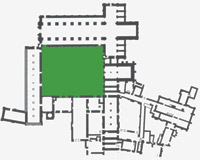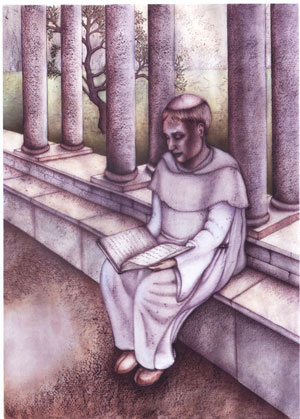|
|
You are here:
 Kirkstall Abbey: the cloister
Kirkstall Abbey: the cloister
 (1/2) (1/2) |
At Kirkstall, as in all Cistercian houses, the
cloister stood at the centre of the precinct, where it was sheltered
from noise and disruption. Access to outsiders was restricted and
silence was observed, making this an appropriate atmosphere for
meditation and prayer. The cloister was made up of a grassy area
surrounded by four roofed walkways. Several stones from the arches
which supported the cloister have survived and can be seen in the
Abbey House Museum.
Artist's impression of a monk reading in
the cloister
© Cistercians in Yorkshire
<click to enlarge>
 |
The cloister was at the heart of liturgical
ceremony and ritual. Processions, such as those on Palm Sunday,
Ascension Day and Assumption Day started off in the church and
then entered the cloister through a doorway in the southern aisle
of the nave, and down a series of convex semi-circular steps. The
entire community participated in these processions, which were
led by the abbot or prior; the
monks, novices and lay-brothers followed,
walking in pairs. The
party stopped first at the eastern range, then at the refectory
and finally at the western range. The entire community participated
in these processions, which were led by the abbot or prior who
was followed by the rest of the community walking in pairs. At
the Blessing
of the Water on Sundays, one of the monastic officers sprinkled
water and salt around the cloister in an act of exorcism, while
the community offered blessings in the church.
The cloister was also the setting for the weekly
Maundy, the ritual washing of the monks’ feet which took
place in the south of the cloister each Saturday afternoon between
the Collation reading and Compline,
namely, c. 3.30 pm or 4 pm in winter, and c. 7pm in summer.
<back><next>
|







 (1/2)
(1/2)